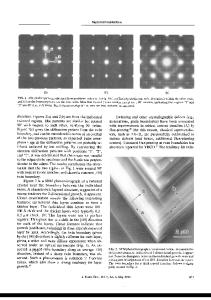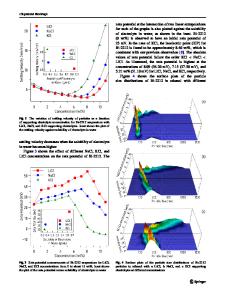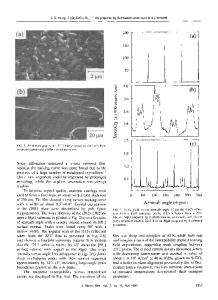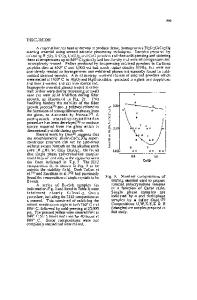Fabrication of Bi 2 Sr 2 CaCu 2 O 8 Superconductor Thick Films on Cu Substrates
- PDF / 1,278,017 Bytes
- 6 Pages / 391.5 x 607.5 pts Page_size
- 11 Downloads / 358 Views
Sang-Chul Han, Tae-Hyun Sung, Young-Hee Han, Jun-Seong Lee, and Sang-Joon Kim 103-16 Munji-dong, Yusong-gu, Taejon, Korea, Power System Laboratory, Korea Electric Power Research Institute
ABSTRACT Well oriented Bi2 Sr 2CaCu 2Os(Bi2212) superconductor thick films were formed successfully on Cu tapes by liquid reaction between Cu-free precursors and Cu tapes. Cu-free Bi-Sr-Ca-O powder mixtures were screen-printed on Cu tapes and heat-treated at 850-870'C for several minutes in air. Cu-free precursors were composed of BixSrCaOy(x= 1.2-2). In order to obtain the optimum heat-treatment condition, we studied on effects of the precursor composition, heattreatment temperature and time, the screen-printing thickness, and the heat-treatment atmosphere on the superconducting properties of Bi2212 films. Microstructures and phases of films were analyzed by XRD and optical microscopy. The electric properties of superconducting films were examined by the four probe method. At heat-treatment temperature, the specimens were in a partially molten state by liquid reaction between CuO in the oxidized copper tape and the precursors. The non-superconducting phases in the molten state are mixtures of Bi-free phase and Cu-free phases. INTRODUCTION An impressive progress has been made in large scale application of HTS (high temperature superconducting) wire technology in last few years and close to a commercial performance level [1,2]. The U.S. Department of Energy announced an award of a project to Pirelli to install and demonstrate the HTS power cable of 100 MW scale in Detroit Edison's network by the end of
year 2000 [31. Soon after HTS materials were discovered, scientists have dramatically improved operating temperatures. But in manufacturing ceramic-based HTS wire they have difficulties in making strong, flexible wires out of materials that are as brittle as blown glass. So researchers began experimenting with many novel wire-making methods to obtain HTS wires of high critical current density, sufficient strength and flexibility to be handled. By 1995, two manufacturing techniques showed great potential for producing high-performance HTS wires. They are the silver-sheathed BSCCO powder-in-tube (PIT) method [4] and the YBCO coated-conductor method [5]. Up to date, the PIT method has been the most useful method because of its applicability to high-production manufacturing. The coated conductor method is not likely to perfect after 10 years because of the difficulty in the fabrication of long wires. In spite of the 411
Mat. Res. Soc. Symp. Proc. Vol. 623 © 2000 Materials Research Society
relatively impressive performance of PIT wires, there remains a serious high cost problem for the technology to make broad commercial impact, competing directly with copper wires in power applications. The high cost is attributed to the complex process for PIT wire manufacturing and the price of the silver sheath. The object of this study is to develop a process to fabricate Bi 2Sr2CaCu 2Ox (Bi2212) tapes at a reduced cost by using less expensive m
Data Loading...











